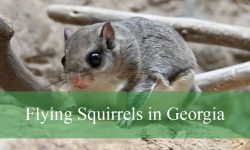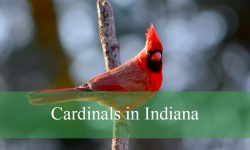Woodpeckers are fascinating birds, instantly recognizable by their distinctive drumming sound as they tap on trees in search of food, to communicate with others, or to create nesting sites. Found across the globe, there are more than 200 species of woodpeckers, each with its own unique characteristics, habits, and regional habitats.
While woodpeckers can be found on every continent except Antarctica, North America is home to a particularly diverse array of species. From the massive Pileated Woodpecker to the tiny Downy Woodpecker, these birds are a common sight in forests, woodlands, and even urban areas across the continent.
Whether you’re an avid birdwatcher or just curious about these remarkable creatures, this article will explore 25 types of woodpeckers, focusing especially on those found in North America. We’ll provide detailed identification tips and include pictures to help you recognize these incredible birds in their natural habitats.
Different Types of Woodpeckers
Red-headed Woodpecker
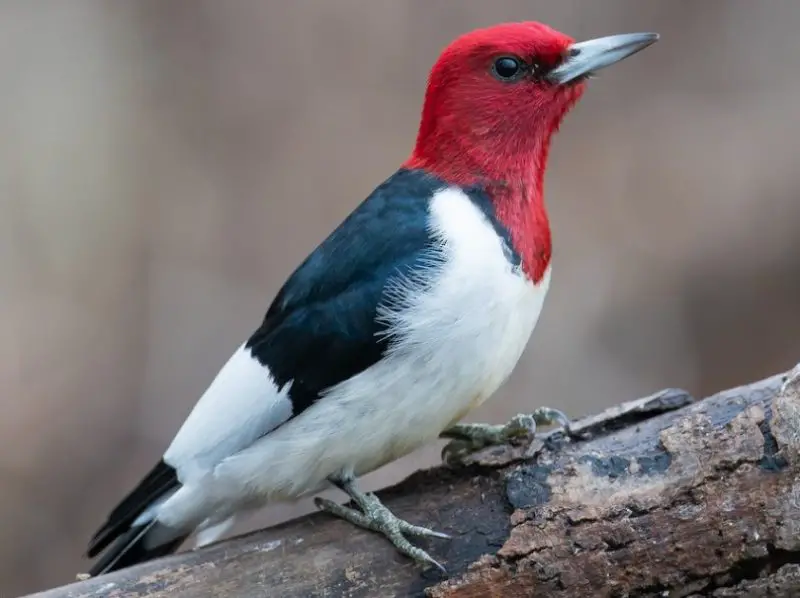
Red-headed woodpeckers (Melanerpes erythrocephalus) are known for their striking appearance, featuring a bright crimson head, black back, large white wing patches, and a white belly. Unlike most woodpeckers with intricate patterns, their bold color blocks make them easily recognizable. These birds measure about 7-9 inches in length and are found mostly in the eastern half of the U.S., although they are less common in New England. They are known for their territorial nature, aggressively defending nesting sites by removing eggs from other birds’ nests.
Red-headed woodpeckers prefer open woodlands, pine plantations, standing dead wood in beaver swamps, river bottoms, orchards, and swamps. They nest in cavities of dead trees or branches, laying 4-7 eggs per clutch. These woodpeckers feed on wood-boring insects, nuts, and occasionally catch insects mid-flight. They have a unique habit of storing food, including insects like grasshoppers, in cracks of wood or under shingles. Unfortunately, their population is declining due to the loss of dead trees, which are often removed for firewood, aesthetics, or pest control.
Pileated Woodpecker
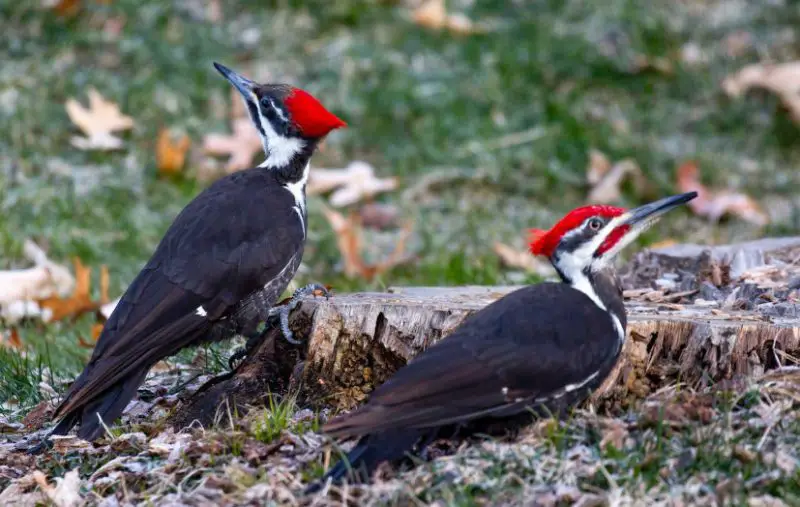
Pileated woodpeckers (Dryocopus pileatus) are the largest North American woodpeckers, measuring 16-19 inches long. They are predominantly black with a striking red crest, black and white striped faces, and white wing linings. Males can be identified by a red “mustache” mark. These birds inhabit mature forests with large trees but can occasionally be seen in suburban backyards. Their diet primarily consists of ants and wood-boring insects, supplemented by berries.
These woodpeckers excavate large, rectangular holes, sometimes up to seven inches across, to reach insects hidden deep within tree trunks. This activity is so vigorous that they can snap smaller trees in half. Pileated woodpeckers nest in cavities they carve in dead trunks or limbs of live trees, laying 3-8 eggs on a bed of wood chips. Although they faced population decline due to extensive logging in the 18th and 19th centuries, they have made a comeback as forests regrew. They are now adapting well to younger forests and continue to thrive across the eastern U.S., most of Canada, and the northern west coast.
Red-bellied Woodpecker
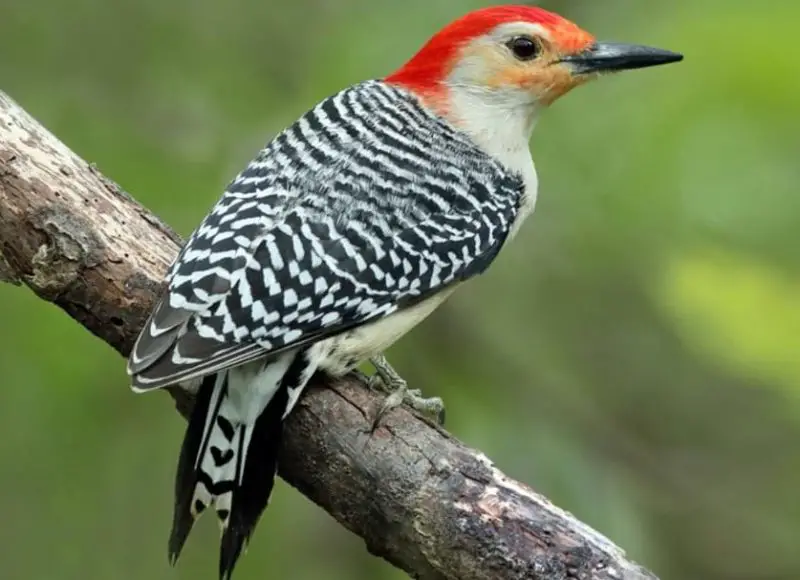
The Red-bellied woodpecker (Melanerpes carolinus) is recognized by its black and white speckled back and pale breast. Despite its name, the reddish tint on its belly is faint and often difficult to spot. Males display a red hood from the beak down the neck, while females only have red on the nape. Often confused with the Red-headed woodpecker, they are found throughout the eastern U.S., extending into southern New England.
These adaptable birds inhabit open woodlands, farmlands, orchards, shade trees, and parks, thriving even in suburban areas. Their diet consists of insects, fruits, and seeds, and they frequently visit backyard feeders. Red-bellied woodpeckers are known for their extraordinary tongues, which can extend two inches beyond the beak and are tipped with a barb for catching insects. They also use their tongues to puncture fruits and lap out the pulp, demonstrating their versatile feeding habits.
Downy Woodpecker
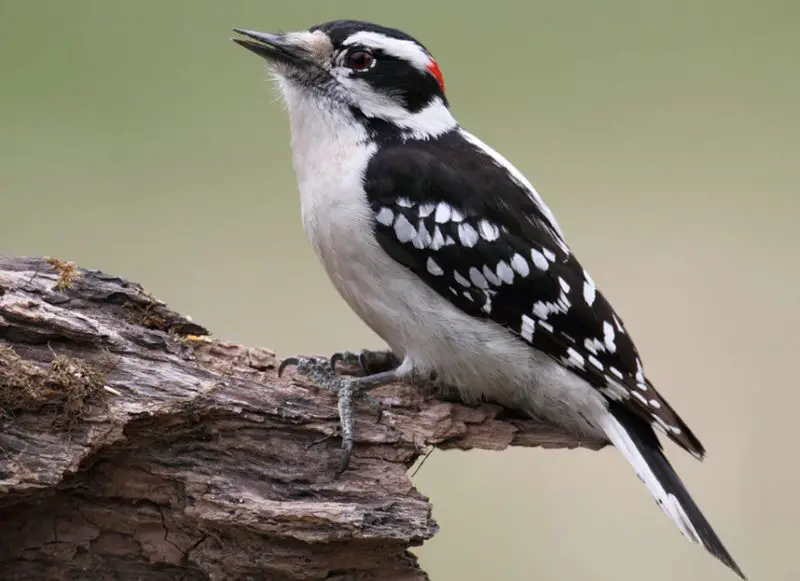
The Downy woodpecker (Picoides pubescens) is the smallest North American woodpecker, measuring just 6-7 inches. It has black and white upper parts, a white stripe down its back, and a black and white striped face. Males can be identified by a red patch on the nape. These woodpeckers are widespread across the U.S. and Canada, living in open woodlands, orchards, parks, and even suburban backyards.
Downy woodpeckers feed on wood-boring insects, berries, and seeds. They are often seen at bird feeders, eating suet and seeds, and are known to sip nectar from hummingbird feeders. Unlike other woodpeckers, they prefer to pick insects from bark crevices rather than drilling into trees. In winter, they join mixed-species feeding flocks, benefiting from social feeding strategies. Their presence helps control insect populations, making them valuable allies in maintaining ecological balance.
Hairy Woodpecker
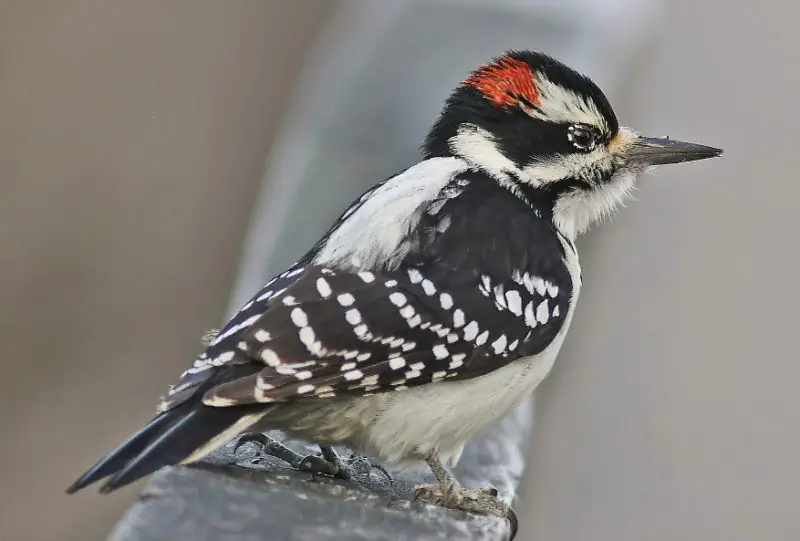
Hairy woodpeckers (Picoides villosus) resemble Downy woodpeckers but are larger (8.5-10 inches) with longer bills. They are distinguished by their black wings with white spots, a white stripe down the back, and an all-white belly. Males have a red patch on the nape. They feed on wood-boring insects, berries, and seeds and are found across the U.S., Canada, and parts of Mexico in mature forests, orchards, and parks.
These woodpeckers play a crucial role in forest health by preying on insects that damage trees. They are known to follow Pileated woodpeckers to forage in the deep holes left behind. Their drumming on trees not only establishes territory but also contributes to the forest’s auditory landscape. Hairy woodpeckers are indicators of healthy forests and support biodiversity by excavating tree cavities used by other species for nesting.
Red-cockaded Woodpecker
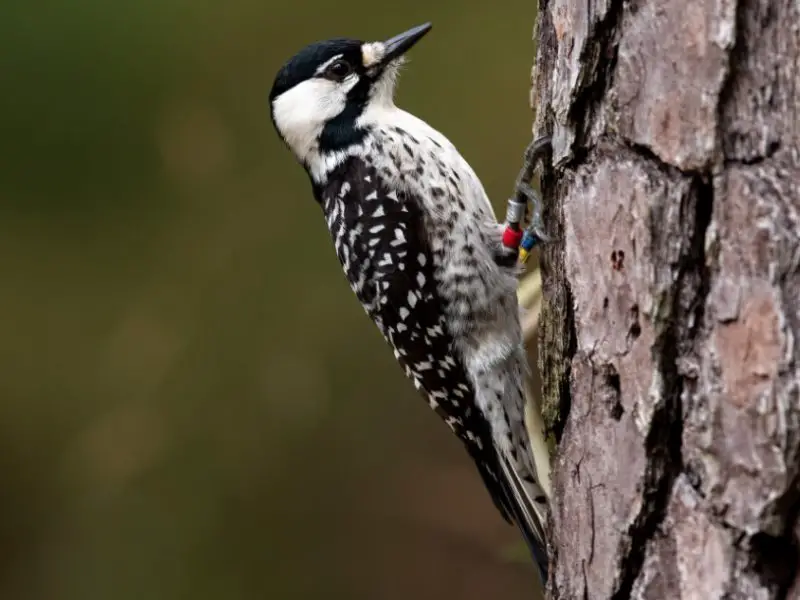
The Red-cockaded Woodpecker (Leuconotopicus borealis) is distinguished by its striking black and white pattern, a prominent white cheek, and a barred back. Males have a small red spot at the back of the crown, which gives the species its name. They primarily feed on wood-boring insects and reside in open pine forests. These woodpeckers are unique in nesting within living pine trees affected by red-heart disease—a fungal condition that softens the heartwood, making it easier for them to carve out nesting cavities. Unfortunately, these trees are becoming scarce due to forest harvesting practices.
This species is known for its cooperative breeding behavior, where older offspring assist parents in raising the next generation. Red-cockaded Woodpeckers live in loose colonies within mature pine forests and typically lay 2-5 eggs in decayed heartwood cavities. These nest cavities can be reused for many years. Due to habitat loss, they have been listed as endangered since 1973, with possibly only four remaining population groups in the southeastern United States. Conservation efforts, including maintaining longleaf pine ecosystems through controlled burns, are crucial for their survival.
Lewis’s Woodpecker
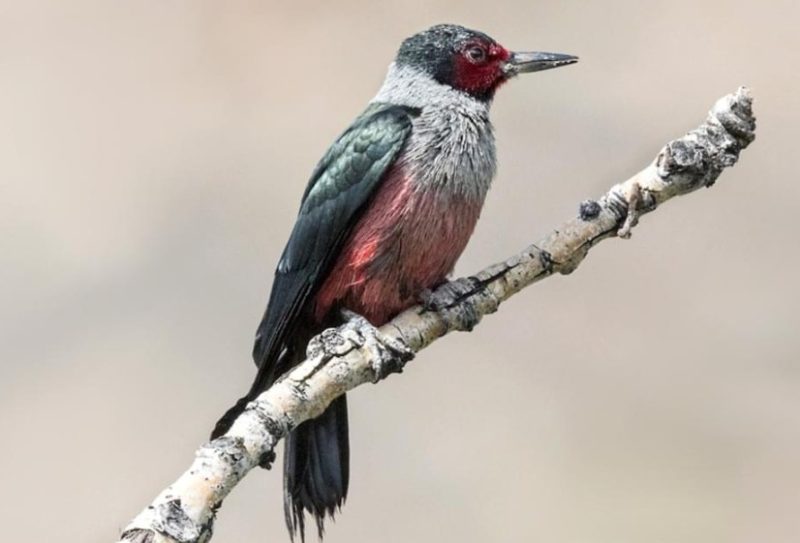
Lewis’s Woodpecker (Melanerpes lewis) is easily recognized by its dark glossy-green head and back, gray collar, red face, and pinkish belly. Unlike most woodpeckers, it has broad, rounded wings and a unique flight pattern resembling that of a crow. It feeds on insects caught in flight and also consumes berries, nuts, and acorns. Found in open pine woodlands and scattered tree groves across the western U.S., Lewis’s Woodpeckers are often seen perching openly on wires, a behavior uncommon among woodpeckers. They are social birds, frequently spotted in family groups.
This species nests in cavities within dead branches or stumps, laying 5-9 eggs. Named after explorer Meriwether Lewis, this woodpecker was first recorded during the Lewis & Clark expedition in 1805. Uniquely, Lewis’s Woodpeckers exhibit nomadic behavior, migrating long distances in search of food, particularly following acorn crops. They also store food in tree crevices for winter use. Conservation efforts to preserve oak and pine forests are essential to maintaining their population, highlighting the species’ dependence on specific habitats and food sources.
Acorn Woodpecker
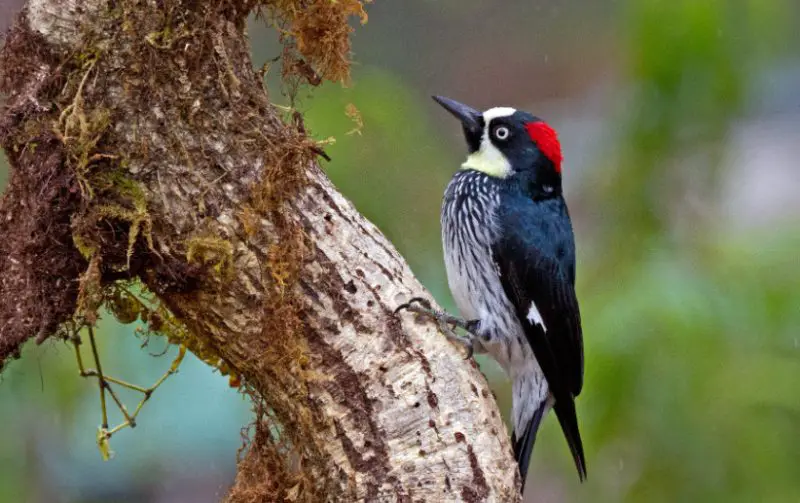
The Acorn Woodpecker (Melanerpes formicivorus) is easily identified by its black plumage, red cap, distinctive black eye mask, yellowish forehead, and pale eyes. Its glossy black body is contrasted by a white rump and a streaked chest. This species feeds on insects, fruit, and acorns, which are crucial to its winter diet. Acorn Woodpeckers inhabit oak woodlands, groves, and forested canyons, ranging from the U.S. West Coast to Central America. They live in colonies of 3-10 birds, exhibiting a highly social and cooperative lifestyle.
These woodpeckers are known for their remarkable acorn-storing behavior, drilling small holes into tree trunks to securely stash acorns for future use. Some “granary trees” have been found containing up to 50,000 acorns. Their communal living extends to nesting, where all members of the colony help incubate eggs and feed the young. This cooperative breeding strategy enhances their survival and showcases their complex social structure. Protecting oak woodlands is vital for preserving their unique ecosystem and communal way of life.
Gila Woodpecker
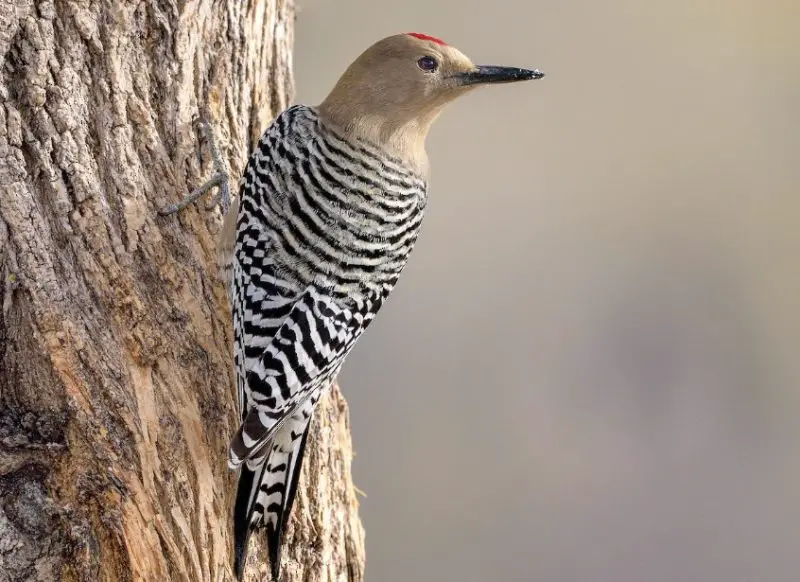
The Gila Woodpecker (Melanerpes uropygialis) is recognized by its barred black and white back, brown face and neck, and a red cap on males. It feeds on insects, fruits, seeds, and occasionally small lizards. Native to deserts of southern Arizona and northeastern Mexico, this species is closely associated with large cacti, especially the saguaro. Gila Woodpeckers excavate nest cavities within saguaros, waiting several months for the inner pulp to dry, forming solid walls within the cavity. They lay 2-7 eggs in these cactus or tree cavities.
This species plays a crucial role in desert ecosystems by providing nesting cavities for other animals once they vacate their nests. However, Gila Woodpecker populations declined by about 49% between 1966 and 2014 due to habitat loss from human development in the Sonoran Desert. Competition with invasive European starlings for nesting sites also poses a threat. Despite the decline, their population is still relatively stable. Conservation of desert habitats and control of invasive species are essential for their continued survival.
American Three-toed Woodpecker
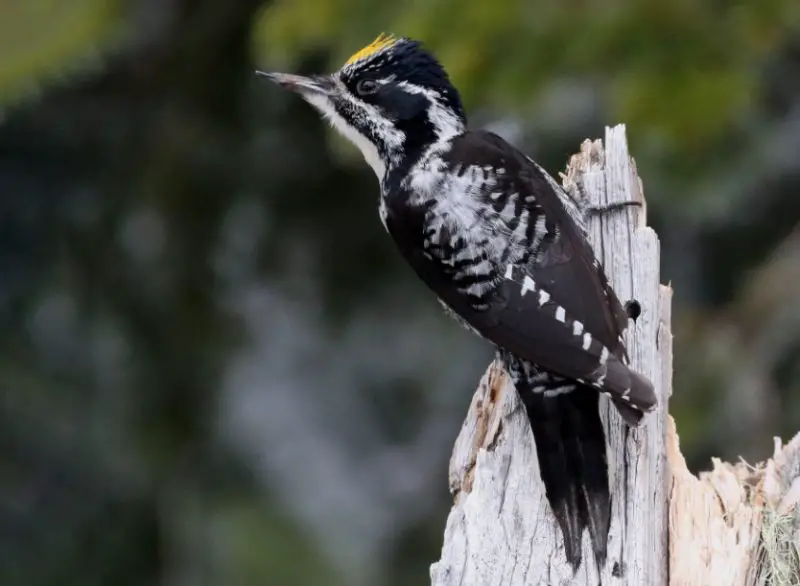
The American Three-toed Woodpecker (Picoides dorsalis) features a black back with a central black and white barred pattern, white underparts, and black-and-white barred flanks. Males are distinguished by a yellow cap. Unlike most woodpeckers, this species has only three toes, all pointing forward. It feeds primarily on wood-boring insects, spiders, and berries. Found across Canada, Alaska, and along the Rocky Mountain corridor, it inhabits coniferous forests, especially in areas affected by wildfires.
This species specializes in exploiting burned forests, feeding on bark and wood-boring beetles that thrive after wildfires. Its unique adaptation to post-fire environments aids forest regeneration by helping decompose dead trees. The American Three-toed Woodpecker typically breeds farther north than any other woodpecker species. Conservation of burned woodland habitats is crucial for their survival, highlighting the importance of natural disturbances in maintaining biodiversity and supporting specialized species like this one.
Black-backed Woodpecker
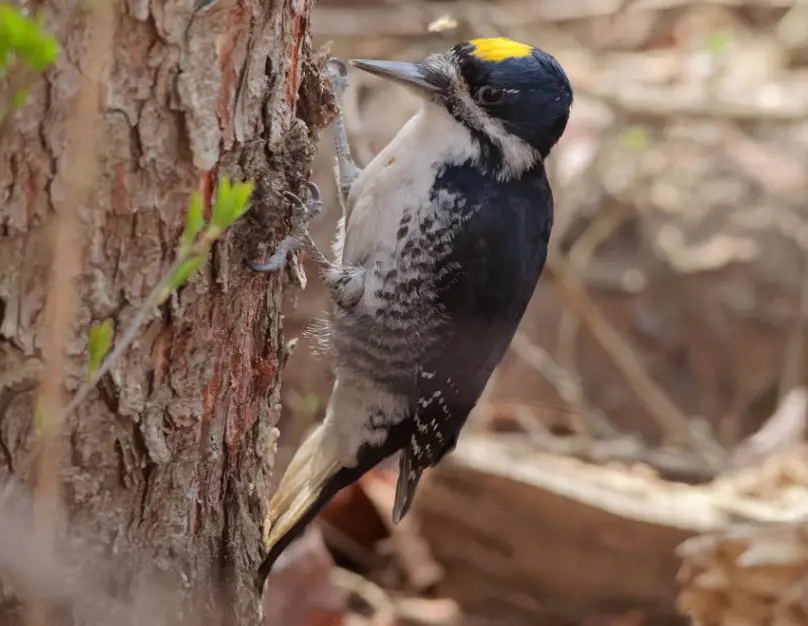
The Black-backed Woodpecker (Picoides arcticus) is distinguished by its entirely black back, wings, and tail, contrasted by mainly white underparts and flanks barred with black and white. The head is black with a characteristic white whisker mark, and males display a yellow cap. Their diet consists of wood-boring insects, spiders, and berries, and they inhabit coniferous forests across Canada into Alaska, as well as sections of the northwestern U.S. and northern California.
Like the American Three-toed Woodpecker, Black-backed Woodpeckers also have only three front-facing toes. However, they show a particular preference for flaking bark off trees rather than drilling, with a special affinity for burned-over sites. These woodpeckers are known to move from one location to another in pursuit of wood-boring beetles thriving in habitats recently affected by fires. They may even venture far south of their usual range into the United States, driven by fluctuations in their preferred food sources or by a need to expand their territory following a population boom.
Golden-fronted Woodpecker
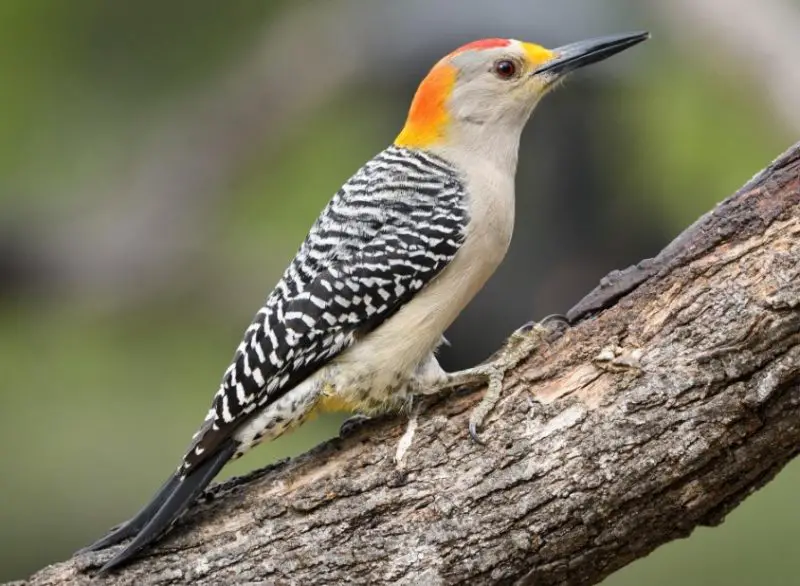
The Golden-fronted Woodpecker (Melanerpes aurifrons) is recognized by its distinctive gold markings located above the beak and at the nape. Their backs are barred black and white, while their face and underparts exhibit a grayish tan coloration. Males are distinguished by a red cap. Their diet includes insects, fruit, and acorns, and they are commonly found in dry woodlands, groves, and mesquite areas across central and southern Texas into the eastern half of Mexico.
These woodpeckers have a particular penchant for using man-made structures like telephone poles and fence posts as nesting sites, often drilling into them so extensively that they cause significant damage. An interesting behavior is observed during the Texas summers when some Golden-fronted Woodpeckers turn their faces purple, a result of their diet heavily consisting of prickly pear cactus fruit. Their adaptability to human-altered landscapes has allowed them to maintain stable populations despite habitat changes.
Ladder-backed Woodpecker
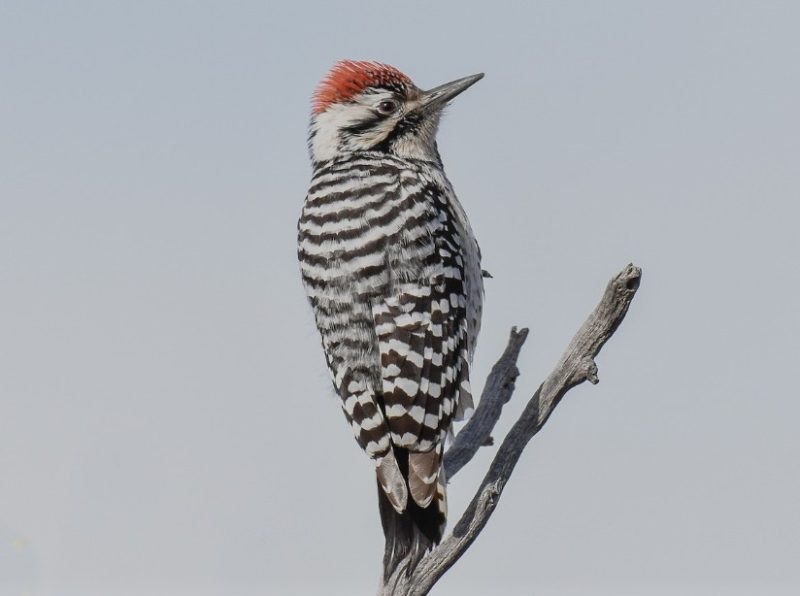
The Ladder-backed Woodpecker (Picoides scalaris) is easily identified by its black and white barring on the back and patterned flanks, with males sporting a red cap. Their diet primarily consists of wood-boring insects, caterpillars, and cactus fruit, and they thrive in arid, dry brushy areas, thickets, and desert environments. Predominantly found in the southeastern U.S. and across most of Mexico, these woodpeckers are well adapted to dry, arid climates.
Despite the scarcity of trees in many of their habitats, Ladder-backed Woodpeckers often make their homes in the giant Saguaro cactus. Their former name, the “Cactus Woodpecker,” reflects this preference. Their small size and agility allow them to deftly maneuver around the thorns and spines of cacti and mesquite. Ladder-backed Woodpeckers share a close relationship with Nuttall’s Woodpecker, although their ranges barely overlap, highlighting the unique adaptations and niches these species have developed.
Nuttall’s Woodpecker
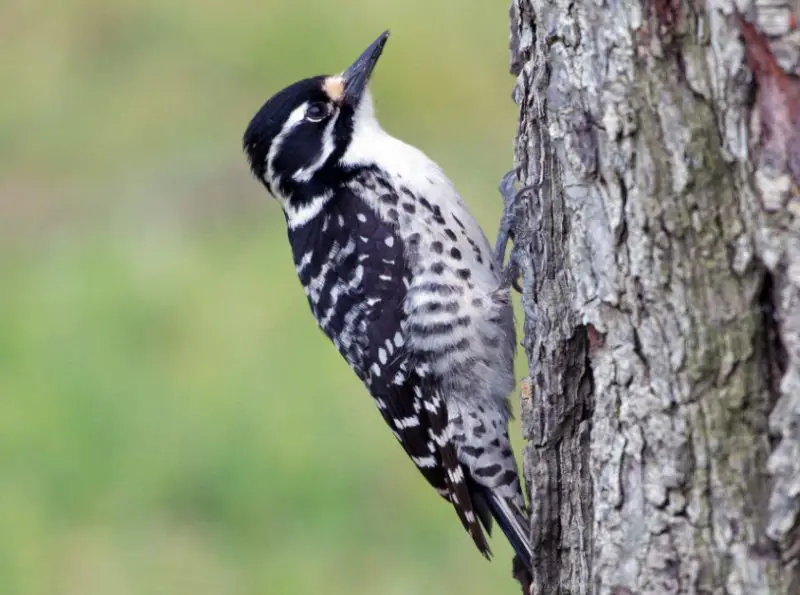
The Nuttall’s Woodpecker (Dryobates nuttallii) can be identified by its black head, white throat and belly, black spots on the breast, and black wings and rump. The adult female has a black forehead, crown, and cap, while the adult male has a red crown and black forehead. The only difference between them and the Ladder-backed Woodpecker is that the Nuttall’s Woodpecker’s red crown extends more toward its neck.
Nuttall’s Woodpeckers primarily feed on insects, favoring beetles, beetle larvae, ants, and millipedes, and occasionally supplement their diet with fruits like blackberries. They inhabit regions west of the southern Cascade Mountains, from southern Oregon to northern Baja California, predominantly within oak woodlands and along streams. Despite their affinity for oak trees, they do not consume acorns.
The species maintains stable populations within these specialized habitats. However, their reliance on limited oak woodland areas raises concerns about potential future risks, especially from environmental changes. A significant threat to their habitat is the spread of Sudden Oak Death, a fungal disease detrimental to oak trees, which could severely impact Nuttall’s Woodpecker populations if it leads to substantial habitat loss.
White-headed Woodpecker
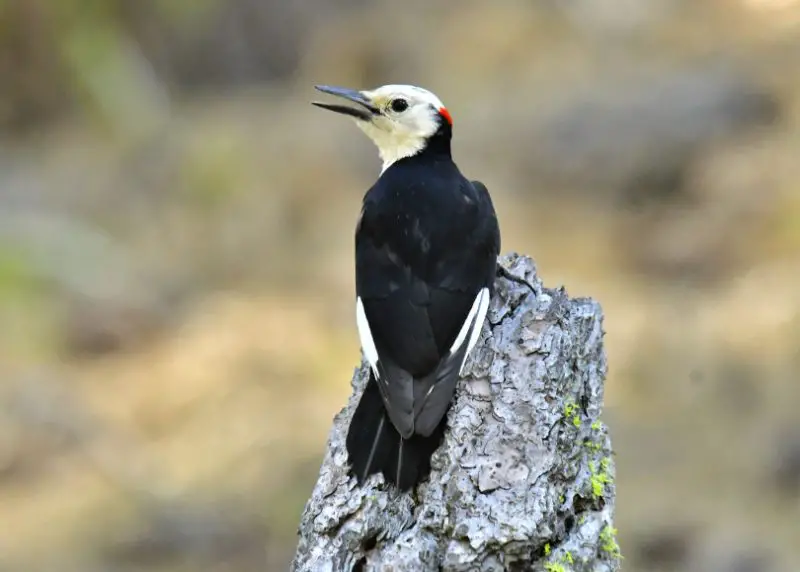
The White-headed Woodpecker (Leuconotopicus albolarvatus) is characterized by its distinctive appearance, featuring a mainly black body, wings, and tail. What sets it apart is its striking white face, crown, and throat, along with a notable white patch on the wing. In males, a small red patch is observed on the nape. This woodpecker sustains itself primarily on a diet of pine seeds and wood-boring insects, showcasing its adaptability to its natural habitat.
These woodpeckers are expert pinecone raiders. They cling to the sides or bottom of unopened pine cones to chip open the scales and remove the seeds. They then wedge the seeds into the crevices of tree bark and hammer them to break them apart. Their preferred environment includes mountain pine forests in pockets of the Pacific Northwest of the U.S.
The White-headed Woodpecker’s specialized diet on pine seeds makes it highly dependent on mature pine forests, especially Ponderosa pines. Conservation of these habitats is crucial for their survival, particularly in regions facing logging and forest fires. Despite these challenges, their populations remain relatively stable due to their adaptability to mountainous coniferous ecosystems.
Arizona Woodpecker
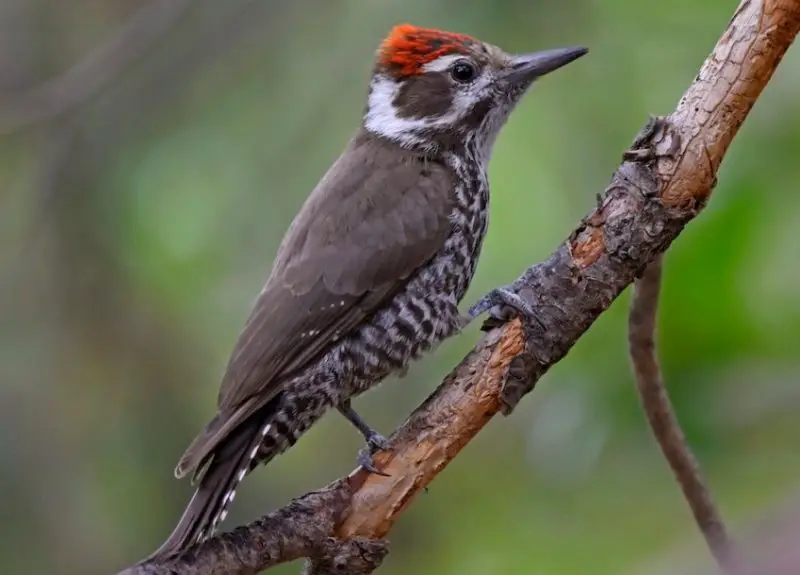
The Arizona woodpecker (Leuconotopicus arizonae) is a medium-sized bird known for its brown and white plumage, which helps it blend into its forested habitat. Unlike many woodpeckers, this species lacks the vibrant red markings commonly seen in others, giving it a more understated appearance. Males are distinguished by a small red patch on the back of their heads, while females are entirely brown and white. Their diet consists mainly of insects, larvae, nuts, and berries, which they forage by pecking into tree bark.
This woodpecker is primarily found in the southwestern United States and Central Mexico. In the U.S., its range is limited to the southern parts of Arizona and New Mexico, where it inhabits mature pine-oak forests. These birds prefer wooded canyons and mountainous regions, making their nests in excavated cavities within dead or decaying trees. The Arizona woodpecker is a year-round resident in its range, with the best chances of spotting one during the breeding season from March to May, when they are most vocal.
Yellow-bellied Sapsucker
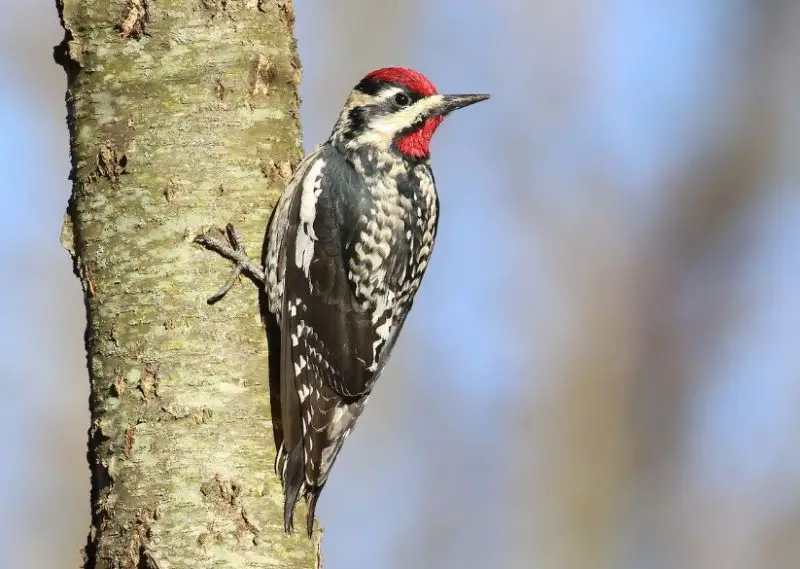
The yellow-bellied sapsucker (Sphyrapicus varius) is easily recognizable by its black and white plumage, with males sporting a bright red crown and throat, while females have a white throat. These medium-sized woodpeckers are known for their distinctive feeding behavior, drilling neat rows of holes in tree bark to access sap. They have specialized hair-like bristles on their tongues to lick up the sap, which also attracts insects that they readily consume. Their varied diet includes sap, insects, and berries.
This species is found throughout eastern North America, from Canada to Mexico, including the eastern half of the United States. They prefer deciduous and mixed woodlands, especially areas with an abundance of Aspen trees, where they excavate cavities for nesting. Yellow-bellied sapsuckers are migratory birds, breeding in the northern parts of their range and wintering in the southern U.S., Mexico, and Central America.
Red-breasted Sapsucker
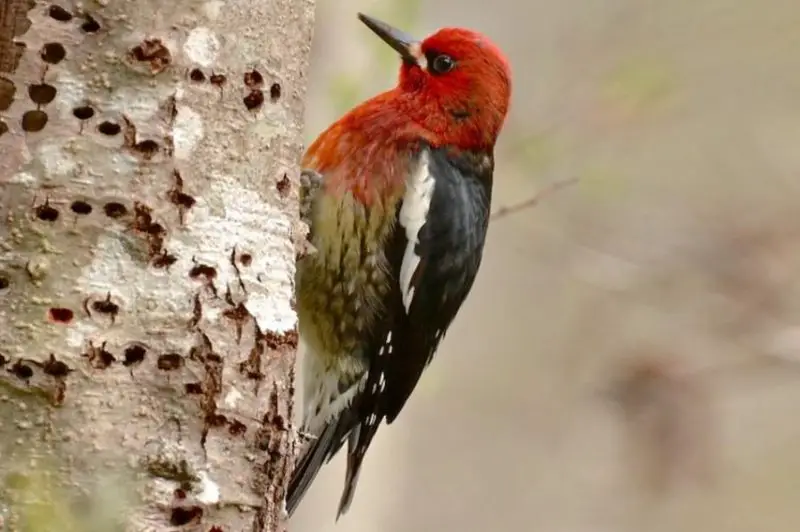
Red-breasted sapsuckers (Sphyrapicus ruber) are known for their vibrant red heads and breasts, contrasted by black and white mottling on their backs and wings. They have a prominent white slash on the shoulder, making them easily distinguishable from other woodpecker species. Their diet consists mainly of tree sap, insects, and berries, obtained by drilling orderly rows of holes in tree bark. They also engage in a unique courtship display, drumming rhythmically on tree trunks to attract mates and establish territory.
This species is primarily found along the far western coast of North America, from British Columbia down through California. They inhabit coniferous and mixed forests, nesting in cavities they excavate in dead or decaying trees. Red-breasted sapsuckers are non-migratory, remaining in their coastal habitats year-round. Their presence plays an essential role in forest ecosystems, as their sap wells provide food for other animals, including hummingbirds and insects.
Red-naped Sapsucker
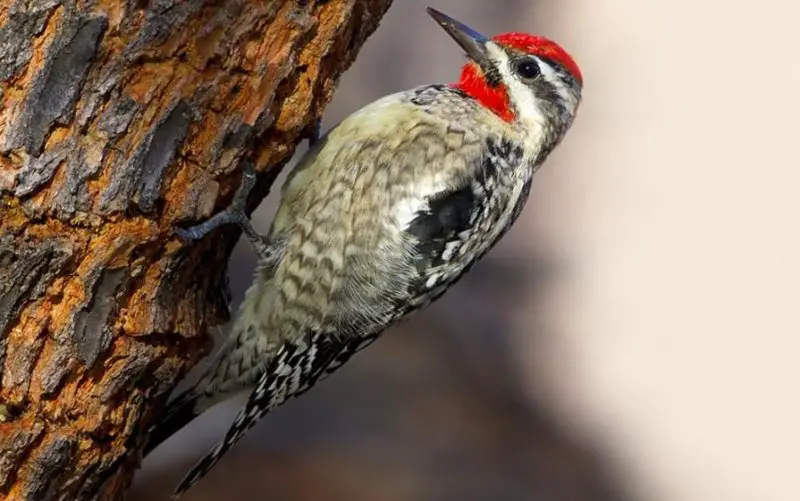
The red-naped sapsucker (Sphyrapicus nuchalis) is characterized by its striking black, white, and red facial markings, along with a prominent white wing slash. Males and females both have a red crown, while males also have a red throat patch. Their diet primarily consists of sap, insects, and berries, obtained by drilling horizontal rows of holes in tree bark. They also consume insects trapped in the sap, providing them with an essential source of protein.
This species is native to the western regions of North America, ranging from the Rocky Mountains to parts of the Pacific Northwest and into Canada. They prefer mixed coniferous and deciduous forests, especially those with Aspen trees, where they excavate nesting cavities in live tree trunks. Red-naped sapsuckers are migratory, breeding in the northern parts of their range and wintering in the southwestern U.S. and Mexico.
Williamson’s Sapsucker
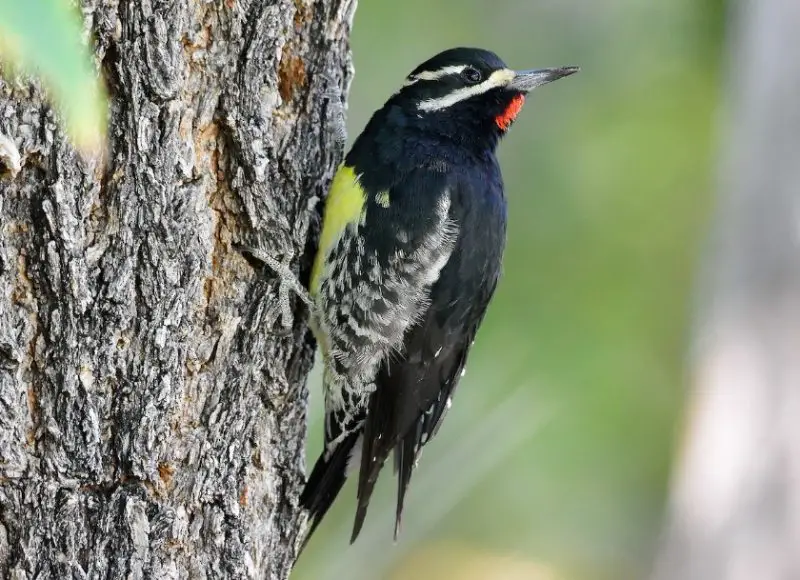
Williamson’s sapsucker (Sphyrapicus thyroideus) is known for its striking sexual dimorphism. Males are predominantly black with a bright red throat, white wing patches, and a vivid yellow belly, while females have a brown head and black-and-white barred patterns on their back and wings. Both sexes share a diet consisting of sap, insects, and berries, which they obtain by drilling sap wells in tree bark. They are also known for their unique migratory patterns, moving between different elevations depending on seasonal changes.
This species inhabits coniferous forests along the Rocky Mountain corridor, ranging from southern British Columbia down to Baja California. They nest in cavities they excavate in live trees, showing a preference for pine and fir species. Williamson’s sapsuckers are known for their adaptability to different forest habitats, migrating vertically to lower elevations during the winter months. Their specialized feeding habits and migration patterns underscore their importance in maintaining forest ecosystem balance.


